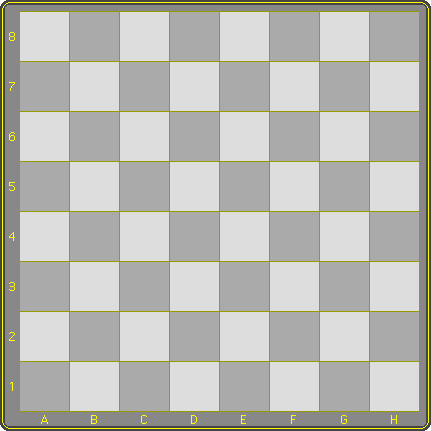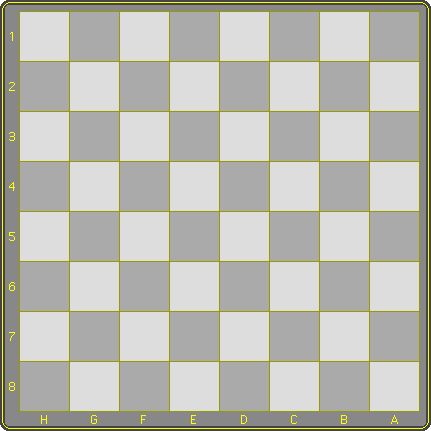Play Chess+ interactively or against an AI
Rules
 | Initial position White pawns on the second row, black pawns on the seventh. Players have their pieces 'in hand' beside the board. Entering and moving 'Entering a piece' means placing a 'piece in hand' on a vacant square behind a pawn on the second row, with the option of moving that pawn one or two squares straight forwards in the same turn, or to capture with it. |
|
José Raúl Capablanca, Edward Lasker, Emanuel Lasker, Bobby Fischer, Herman Hoogland: Why do great players make poor inventors?
| The problem with draws We write 2019, twenty-three years after the introduction of Fischer Random Chess, nowadays usually referred to as Chess960, and two years after the presentation of AlphaZero, marking the definite beginning of machine superiority in Chess, Shogi and Go. Reaching superiority in any other game of this class, that is : symmetric two-player zero-sum games with perfect information, is only restricted by cost/benefit issues. In general when considering these games, problems may arise by the fact that they are completely determined, that is: the status of every legal position is either a win for black, or for white, or it is a draw. The fact that we usually don't know which of the three it is, is actually the foundation on which any such game is played. Tic-Tac-Toe is not a game. Draws The game of Hex is drawless, that is: in its game tree all positions including the initial one are either a win for black or a win for white. The game of Havannah is not drawless but among tens of thousands of games at Little Golem there has been only one single draw between humans, on a base-8 board. In high level Chess draws are common and in high level Draughts they are far too common. The argument that it is due to 'the players' mentality' is only partly true. Players can indeed 'play for a draw' but only if the game allows it. You cannot play for a draw in Havannah. A margin of draws established in prolongued high level play roughly corresponds to an actual percentage of drawn positions in the game tree. A theoretical count is difficult, not only because of the sheer size of game trees, but also because they contain all legal positions, including zillions of nonsensical ones. Things to come Chess' margin of draws isn't problematic in a structural sense but it may become problematic because of two things, the size of the game and machine superiority. Till not so long ago, Chess theory was pushed forward by grandmasters and masters. Now it's being pulled forward by superior AI. Its goal is to avoid mistakes. Chess, if played by the Gods, would end in a draw. That's why the Gods don't play Chess, they play games with the humans who created them. For one and a half centuries grandmasters and masters have pushed the boundaries between the theoretically safe alleys that their combined efforts did carve out, and the Great Unknown beyond. Now, with AI showing the way, the process has reached a point where the Great Unknown noticably starts to shrink. With theory extending way into the middle game and the means to follow it, have it tested by AI and build on it ever more accessible, top players increasingly find that once a game is beyond known theory, the means to actually force a win have been significantly depleted. |
| You could see it coming like climate change. Capablanca in an interview in 1925 already gave as his opinion that Chess would drown in drawishness within fifty years. Make that a hundred and some truth is starting to shine through. And he even suggested a solution by reintroducing two composite pieces that are missing from Chess, the 'bishop+knight' and the 'rook+knight'. He was a very good player, but as an inventor he held on to something that to him seemed fundamental: pieces on the back rank and pawns on the second. Thus Capablanca Chess ended up on a 10x8 board with rooks tucked away in the corner, and with the obvious need for a castling rule. I later made Grand Chess which by many, including me, is considered the best 'complete Chess'. Playing it next to Chess would also mark the end of the possibility for players to stay within known theory for far beyond the opening, and the end of all problems related to that. But it's like the reaction to climate change: disasters must happen before people change. Chess deserves to be played with a complete set of pieces but for now it is still easy to ignore or even deny any problems. |  José Raúl Capablanca |
 Bobby Fischer | At least one man felt that it was a disaster already. Bobby Fischer saw his genius being obstructed by players with a knack for study and a large capacity for storing theory. It's not only the size of the game that opens the possibility, but also the fixed initial position from which all opening alleys radiate. Study pays off in such a well charted terrain and the advance of theory, although inherently slow, was accumulative and steady, like the warming of the Earth. Fischer saw good arguments for Chess to become bogged down by draws. So he devised Fischer Random Chess. The idea was to randomise the opening setup to eliminate preparation. But 'Shuffle Chess' already did that so some sophistication was called for to improve on 'the anarchy of the fully randomized game'. To that effect Fischer introduced a restriction: the king should be placed between the rooks. Why? As an inventor I'd say it beats me, but it allowed him to formulate a modified castling protocol. Why? Again I'd say it beats me, totally. Castling isn't structurally inherent in Chess, it's a fix for a specific problem in regular Chess. |
| I fully recognise the fact that Chess960 works as intended. A prominent group of Chess players found all 960 initial positions to be 'workable', which doesn't surprise me at all. Show me an 'unworkable' Shuffle Chess setup. And another thing works for it: you can play it with a regular chess set. What I don't understand is:
I consider Chess960 to be an abominable implementation but had no further thoughts about it because I felt and still feel that Grand Chess may eventually gain momentum. But then Nick Bentley published a provisional idea of an entering protocol in which regular moves would also be conditionally possible, with the aim to merge both phases. That made sense, but the suggested implementation featured tokens on the back row that would gradually be replaced by entered pieces. That made less sense so I mailed Nick and suggested to use the pawns as tokens, not to be replaced but to indicate entering squares. It went from there and it didn't take us long to dream up the Chess+ protocol. Let's compare the factual similarities and differences with Chess960.
|
I just want to make a point: good players are not automatically good inventors and I wish I would have had a chance to talk with him about that, back in the nineties.
An example game
| ||||||||
| This is the first ever Chess+ game, played between Luis Bolaños Mures and yours truly, Christian Freeling. It testifies to the fact that I'm a poor Chess player with a talent for blatant oversights. The one here is rather funny. | ||||||||
Why we invented Chess+
External links
Enschede, November 15, 2019
christian freeling















